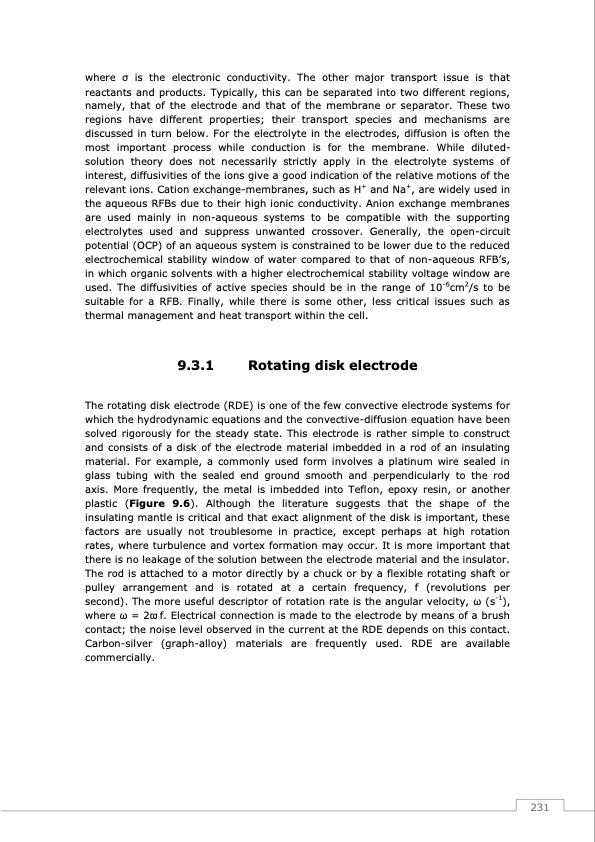
PDF Publication Title:
Text from PDF Page: 232
where σ is the electronic conductivity. The other major transport issue is that reactants and products. Typically, this can be separated into two different regions, namely, that of the electrode and that of the membrane or separator. These two regions have different properties; their transport species and mechanisms are discussed in turn below. For the electrolyte in the electrodes, diffusion is often the most important process while conduction is for the membrane. While diluted- solution theory does not necessarily strictly apply in the electrolyte systems of interest, diffusivities of the ions give a good indication of the relative motions of the relevant ions. Cation exchange-membranes, such as H+ and Na+, are widely used in the aqueous RFBs due to their high ionic conductivity. Anion exchange membranes are used mainly in non-aqueous systems to be compatible with the supporting electrolytes used and suppress unwanted crossover. Generally, the open-circuit potential (OCP) of an aqueous system is constrained to be lower due to the reduced electrochemical stability window of water compared to that of non-aqueous RFB’s, in which organic solvents with a higher electrochemical stability voltage window are used. The diffusivities of active species should be in the range of 10-6cm2/s to be suitable for a RFB. Finally, while there is some other, less critical issues such as thermal management and heat transport within the cell. 9.3.1 Rotating disk electrode The rotating disk electrode (RDE) is one of the few convective electrode systems for which the hydrodynamic equations and the convective-diffusion equation have been solved rigorously for the steady state. This electrode is rather simple to construct and consists of a disk of the electrode material imbedded in a rod of an insulating material. For example, a commonly used form involves a platinum wire sealed in glass tubing with the sealed end ground smooth and perpendicularly to the rod axis. More frequently, the metal is imbedded into Teflon, epoxy resin, or another plastic (Figure 9.6). Although the literature suggests that the shape of the insulating mantle is critical and that exact alignment of the disk is important, these factors are usually not troublesome in practice, except perhaps at high rotation rates, where turbulence and vortex formation may occur. It is more important that there is no leakage of the solution between the electrode material and the insulator. The rod is attached to a motor directly by a chuck or by a flexible rotating shaft or pulley arrangement and is rotated at a certain frequency, f (revolutions per second). The more useful descriptor of rotation rate is the angular velocity, ω (s-1), where ω = 2π f. Electrical connection is made to the electrode by means of a brush contact; the noise level observed in the current at the RDE depends on this contact. Carbon-silver (graph-alloy) materials are frequently used. RDE are available commercially. 231PDF Image | Redox Flow Batteries Vanadium to Earth Quinones

PDF Search Title:
Redox Flow Batteries Vanadium to Earth QuinonesOriginal File Name Searched:
FJVG_TESIS.pdfDIY PDF Search: Google It | Yahoo | Bing
Salgenx Redox Flow Battery Technology: Salt water flow battery technology with low cost and great energy density that can be used for power storage and thermal storage. Let us de-risk your production using our license. Our aqueous flow battery is less cost than Tesla Megapack and available faster. Redox flow battery. No membrane needed like with Vanadium, or Bromine. Salgenx flow battery
| CONTACT TEL: 608-238-6001 Email: greg@salgenx.com | RSS | AMP |